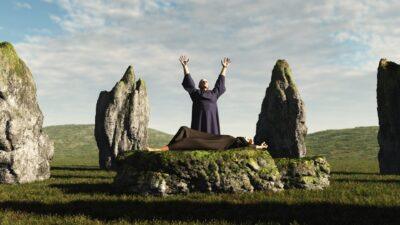|
Listen To The Article
|
Pagan Religion’s “To Be As God” Worldview
The serpent’s words in the garden…”Thou shalt not surely die”… implied an entire worldview that was radically at odds with God’s revelation of Himself and the foundational structure of the world He created. Think about it this way… if God couldn’t deliver on His threat to punish Adam and Eve for violating His law regarding “the tree”… then the world could not be His creation.
If it was all just a bluff as the serpent suggested, the world must be self-existent and self-defining. No God needed. People just are and the world simply is. The universe might be in some sense unfolding, developing or evolving… but with no creator, it’s left as John Lennon said, “no hell below us, above us only sky.”
That also means that the appearance of gods or men on the historical scene must be strictly naturalistic and there can be no final distinction between the essence of the gods and that of mere humans. All being is one being. All rises out of the One and all returns to the One. Philosophers call this the continuity of being.
Pagan Religion And Polytheism
In traditional terms, it might be said that the serpent was the first to practice atheism. This is because he denied the existence of a transcendent Creator, a personal God to whom men owe total obedience. Interestingly, the serpent also insisted on a form of pantheism: all reality was of one piece, and all parts of reality, including man, were actually or potentially divine.
But there’s more. The serpent also insisted on polytheism. He maintained that there were many immanent forces that made up reality. None were absolute and none were sovereign. Each exercised some power within its particular realm or sphere, but the territorial sovereignty of each was limited and checked by the powers of all the others. However, it didn’t end there…
Man could be such a god too, the serpent said. And so begins the case for humanism, a religious philosophy that makes man the center of all things.
Pagan Religion And The Continuity Of Being
Now, since all reality is one in this worldview, the power or energy manifested anywhere in the world must be echoed or reflected everywhere in the world. The “divine energies” of the cosmos manifest themselves in the tiniest corners of reality… in tea leaves, birds’ livers, or scattered sticks thrown to unveil the future. “As above, so below.” The macrocosm is the microcosm.
Nevertheless, the converse is also true. The smallest ritual act at the edge of a fading reality can move all of it. A hand-cranked gear in this worldview can move the entire universe. “As below, so above.” This is the foundation of divination and magic.
The Basic Elements Of All Pagan Religion
In the serpent’s worldview, these would serve as man’s ultimate defense against other competing “powers” as well as his weapons and tools for asserting his own godhood.
Continuity of being. Cosmic evolution. Atheism. Pantheism. Polytheism. Humanism. Magic. These are the basic elements of the serpent’s worldview and they lie at the heart of all pagan religion.
The Development Of Pagan Religion
There were two times in human history when the whole human family knew God and understood His claims on man. The first was when Adam and Eve left the Garden and began their climb down the plateau of Eden toward the inhospitable wilderness below. The second was when Noah and his family looked out over their new world from the rugged crests of Mt. Ararat.
In the wake of creation and curse, of Deluge and re-creation, man knew exactly who God was and the terrible dangers that came with defying Him. And incredibly, even after God’s massive demonstrations of His power and might, man once again rushes headlong into the foolish pretension of being his own god. Once more his search for power begets a new religion.
Romans 1 from Holy Scripture gives us some broad outlines concerning the development of pagan religion. First, ancient man, just like modern man, became unthankful. He despised God’s provision and resented His sovereignty and providence. Pagan man rejected God’s mandates and laws. Eventually, he began to hate his own creature-hood.
Pagan Religion And The Attempt To Reinvent God
And so ancient man, imagining himself wise, begins the process of reinventing God in his own image. Out of a sin-darkened heart, he changed and exchanged the glory of God into “an image made like to corruptible man, and to birds, and four-footed beasts, and creeping things” (Rom. 1:23).
There seems to be a downward progression in this passage: man, bird, beast, and snake. Notwithstanding, Scripture doesn’t really give us a timeline for this downward integration into the void. In fact, there is a great deal we don’t know about the ups and downs of historical development.
The worldwide flood and more than four thousand years stand between the antediluvian apostasy and our day. As finite beings, it’s pretty tough for us to draw definitive charts and graphs marking God’s curses and blessings in history. Yet, we do get a few clues as to what kills a culture at Babel.
Pagan Religion And The Need For “The Right Magic”
The Tower, the first postdiluvian ziggurat, was designed to be technology anchored in magic. Its top was to be “unto heaven” (Gen. 11:4). Here we see an attempt to implement, impose and make real the continuity of being. Heaven and earth are essentially one and the same.
The foundational thinking here is that the right magic can act as a bridge, establish man in his deity and make him equal with God. The goal has always been the same: unify man in his rebellion against God and restore Paradise humanistically. The pyramids carried the same message.
After Babel, we first hear of kings and queens who were exalted to godhood—Belus, Ninus, and Semiramis, for example. It should be remembered that at an early date, the pharaohs of Egypt were declared sons of the divine Sun.
Ancient Pagan Kings And Ancient Pagan Beasts
In general, the kings of the ancient world were recognized as human-divine mediators, sons of the gods, who maintained life and fertility within their kingdoms by their command of ritual magic.
There are bits and pieces of this activity mentioned in Scripture, and it comes to full expression explicitly in the Book of Revelation: “And all the world wondered after the beast. And they worshipped the beast, saying, Who is like unto the beast?”
When John wrote these words, the monster on the throne of the Roman Empire called himself the son of God. Humanism indeed.
Sacrificing To Demons
There is another dimension to pagan religion that is extremely important for us to consider. It was demonic in the most literal sense. Behind the magic, rituals, false gods and the idols were demons. Moses testifies to this when he writes of Israel (Deut. 32:17):
They sacrificed to demons, not to God,
To gods they did not know,
To new gods, new arrivals
That your fathers did not fear.
And the psalmist says of later generations…
And they served idols: which were a snare unto them. Yea, they sacrificed their sons and their daughters unto devils, and shed innocent blood, even the blood of their sons and of their daughters, whom they sacrificed unto the idols of Canaan: and the land was polluted with blood (Ps. 106:36-38).
Christ Puts An End To The Overt Power Of Pagan Religion
Scripture doesn’t tell us to what extent God allowed these demons to interact with their worshippers or what limits He put on their oracles and magic. Certainly, they were on a tight leash anytime one of God’s prophets was on the scene (cf. Ex. 7:10-12; 8:18-19; 1 Kings 18:20-29).
We do know that when Christ came, He dispatched them into the abyss with a word. St. Athanasius, in his On the Incarnation of the Word, assures us that the coming of Christ and the preaching of the gospel effectively banished magic from the pagan world and shut down all its oracles.
However, the takeaway here is that there was a time in our historical past that demons terrorized the ancient world through its man-centered, polytheistic religions. Also, the ancients, in some sense, actually made the magic work in cooperation with these territorial demonic powers.
Conclusion: The Classical World
This then was the religion of the pagan and classical world. It was humanistic and demonic to the core. This is because it rested foundationally on the premise that man can be as God, deciding good and evil for himself. It differed in form from place to place and from era to era, but it was always an expression of the serpent’s basic worldview.
Greek rationalism didn’t overturn it but merely moved in terms of it. Only Christ Himself dispelled its darkness. Only He could send the demons away. There is no neutrality nor is there a grey zone between demonic darkness and His wondrous light.
Ideas have consequences and how we see the world really does affect individual lives and culture. After all, it wasn’t pagan religion that built this country. It was a belief in the creator/creature distinction and all of its implications that produced the freedoms we still, to some extent, enjoy.
 Off The Grid News Better Ideas For Off The Grid Living
Off The Grid News Better Ideas For Off The Grid Living





